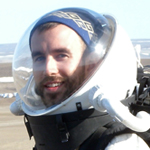As the designated crew astronomer, my addition to the MDRS 89 team was to make full use of the Musk Observatory, complete with donated Celestron telescope and two CCDs (Charged Coupled Device, for digitizing images). Recent events, however have changed my two-week plans, and unfortunately the telescope will not be operational during my mission. It was been disassembled by Crew 87, one of the NASA Spaceward Bound crews, and will either be shipped out before the end of their mission or when Crew 88 takes over the Hab this Saturday. Thus, my plan has been thrown out the airlock.
There is, however, some good news. MDRS is also equipped with a radio telescope through NASA’s Radio JOVE project. This telescope is primarily used to observe both solar and jovian radio signals, although the possibility exists to observe other radio sources. Currently, the radio telescope at MDRS is half-assembled, although Crew 88 will thankfully be completing this assembly during their stay at the Hab.
With only two weeks between now and the start of our crew rotation, this information does necessitate a huge change in my own plans, but I’m taking it as a blessing in disguise. The possibility of solar observing also allows me to do some sort of research during the day (past my aide in the rest of the crew’s work), and I can also do work on radio interference during EVAs as a possible side project. I also won’t be a zombie in the morning after a night of working with the Musk Observatory!
I do also only have two weeks to research potential radio sources, past the planets and Sun, as well as figure out how to actually do research with a radio telescope, as all of my previous astronomy experience rests within the visual range of the EM spectrum. I’ll be keeping an eye on the daily crew reports from Crew 88 to see what their astronomer will be using the radio telescope for, since a collaborative project may be more lucrative that two individual ones, especially with the short timespans involved.
You always have to try to take things in stride, which I’m sure we’ll be doing frequently as a crew during our two weeks on Mars!






